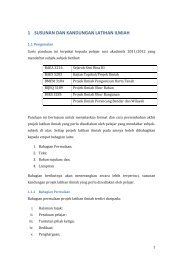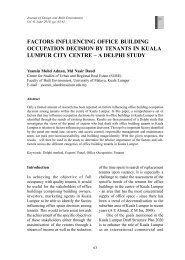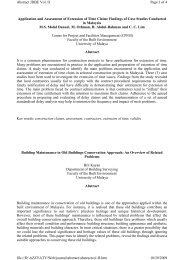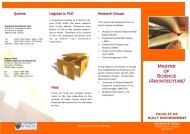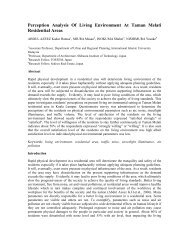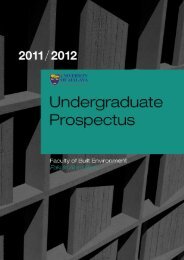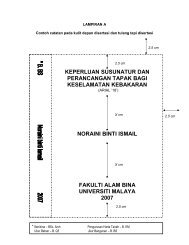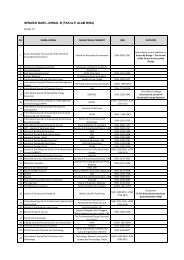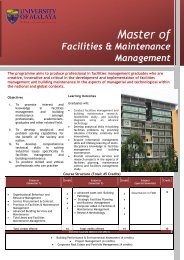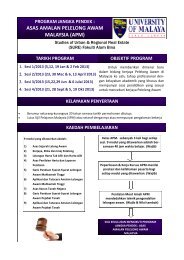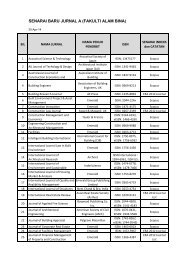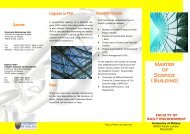comparison method - Faculty of Built Environment
comparison method - Faculty of Built Environment
comparison method - Faculty of Built Environment
You also want an ePaper? Increase the reach of your titles
YUMPU automatically turns print PDFs into web optimized ePapers that Google loves.
From the above discussion, the problems encountered in applying <strong>comparison</strong> <strong>method</strong> in Malaysia are as<br />
follows:<br />
There is the current lack <strong>of</strong> data to guide valuers on the preferred technique <strong>of</strong><br />
adjustment to use, this made valuers uncertain about which technique is more<br />
appropriate to apply.<br />
The valuers are uncertain on which adjustment techniques are most appropriate to<br />
use.<br />
There is lack <strong>of</strong> empirical study to examine how valuers perform the technique and<br />
what are their preferred.<br />
Against the background <strong>of</strong> this situation, there is no data currently in terms <strong>of</strong> the<br />
valuers practise the adjustment on the techniques they prefer (if any)<br />
3.0 Objectives<br />
The specific objectives <strong>of</strong> this research are as follows:<br />
i. To examine the adjustment techniques used by valuers in Malaysia in their practice <strong>of</strong> the<br />
<strong>comparison</strong> <strong>method</strong>.<br />
ii. To determine the sequence for adjustment <strong>of</strong> elements in <strong>comparison</strong> <strong>method</strong>.<br />
iii. To explore the most preferred adjustment techniques by valuers in applying <strong>comparison</strong> <strong>method</strong>.<br />
4.0 Research Methodology<br />
This research has adopted a questionnaire survey <strong>method</strong> for data collection. To achieve the objectives,<br />
the research explores the perceptions <strong>of</strong> related parties on the issues <strong>of</strong> adjustment techniques and<br />
elements <strong>of</strong> adjustment in carrying out the valuation exercises by applying <strong>comparison</strong> <strong>method</strong>..<br />
Interviews were also carried out to strengthen the results.<br />
The questionnaire was divided into three main sections:<br />
<br />
Part A – respondent‟s background.<br />
Part B – views on the adjustment techniques and elements <strong>of</strong> adjustment in carrying out<br />
valuation by <strong>comparison</strong> <strong>method</strong>.<br />
Part C – perceptions on the most preferred adjustment techniques applied by valuers in<br />
Malaysia in carrying out the valuation by <strong>comparison</strong> <strong>method</strong>.<br />
The rationale for this particular format <strong>of</strong> the questionnaire design was so that views and perceptions <strong>of</strong><br />
valuers in Malaysia toward the most preferred adjustment techniques among valuers could be explored.<br />
To ensure the reliability <strong>of</strong> the questions, reliability tests were performed on the questionnaire and the<br />
results are as in Table 1. The overall value <strong>of</strong> above 0.6 for the Cronbach‟s Alpha shows that all variables<br />
had attained internal consistency and achieved high reliability scores based on scales developed by<br />
Sekaran (2000). Based on this theory, a variable that achieves a Cronbach‟s Alpha coefficient value <strong>of</strong><br />
more than 0.6 points is regarded as achieving high internal consistency and reliability. This suggests that<br />
the respective respondents were able to understand the questions in the questionnaires while the necessity<br />
<strong>of</strong> asking the questions was also confirmed.<br />
3



